#Eleanor is just. an essential part of who Max is and is becoming as a person and there's no getting around that for her
Explore tagged Tumblr posts
Text
oooooooo I’d never pegged “Why is this so important to you? Why offer more for this place than the others?” and Max walking away without answering as a parallel/follow-up to “I found a way to stop caring about her. Would you like to know how?” “No.” but it DEFINITELY is!!!!! Like. Did you Max? Did you Really????
#Eleanor is just. an essential part of who Max is and is becoming as a person and there's no getting around that for her#Once Again Thinking about that seemingly throwaway line Frasier has in 2x08 telling Eleanor she has to decide who will#'assume control ostensibly of the operation' AKA which Man#vs. Max having to wield her power secretly behind Featherstone in the end#because as Max says in this scene 'for people like us power in this place is most effective when it is least perceived'#so we know she doesn't Mind quietly wielding power (and in fact views Eleanor's brash nature as a Mistake)#but we also know that she has an appetite for something more re: 'in another time and another place they would call me a queen'#so yeah idk i'm just sad for her#i understand why she made the choices she made but she deserves so much more than civilization has to offer her#bs LB
10 notes
·
View notes
Text
Black Sails Female Costumes: Nassau and London Dresses
This post will delve into what women of the early 18th century would have been wearing and compare that to the costumes worn by many of the women in Black Sails. We’ll look at Max’s costumes once she becomes a madame, Eleanor’s costumes in season 3 onwards, Miranda Barlow/Hamilton’s costumes in both Nassau and London, plus some costumes of minor characters (Mrs Hudson, Abigail Ashe, and Madame Guthrie).
Now, the main thing that the show got right in terms of historical accuracy with these dresses is silhouette. The conical shape of the bodices, the round skirts without the use of panniers, wide and round necklines, use of mantuas for the most part, and sleeves that end below the elbow (though the shape of the sleeves often leaves much to be desired). There are some issues with silhouette - mostly in the posture the women adopt, at the very least Miranda in London and Max in later seasons should be wearing stays that pull their shoulders much farther back to create a more erect posture.
The biggest grievances I have with the women’s costumes in terms of accuracy are color, sleeve shape, and the fact that many stomachers appear to be incorrectly attached, which I will discuss in a moment. Many costumes are also made from modern fabrics with very modern patterns, though I personally am a fan of using modern fabrics on historical dresses.
The main defining feature of early 18th century fashion is the mantua. Essentially the mantua is the outer dress worn during the time, with a stiff bodice and a round skirt. The mantua could be worn in a variety of ways, with the skirt open in the front to reveal a colorful petticoat, with the bodice open in the front to reveal a fancy stomacher, with the bodice loose in the back for a more informal style, or with the skirt bunched up or slightly short with a matching petticoat underneath.
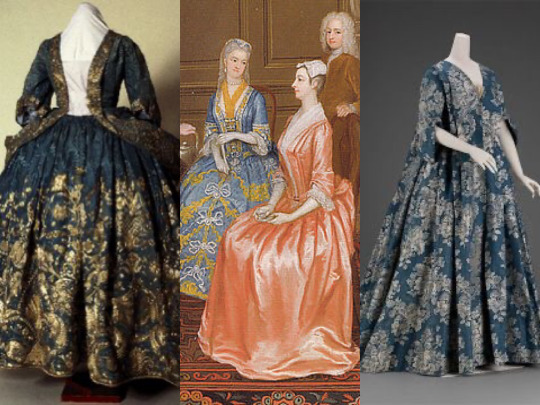
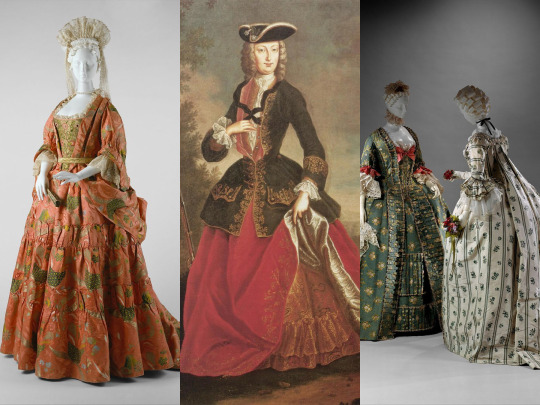
A stomacher was a triangular piece that would have attached to the stays (stays are discussed in my post about the prostitute fashion), with much decoration, that an open fronted mantua would have been worn over and then pinned to. The main problem of the Black Sails stomachers is the way that they are attached. Rather than being worn underneath the mantua, they are simply sewn straight onto it. For fashionistas, the modern equivalent would be wearing a lacy bralette under a low cut top, but then just cutting the lace off and resewing it to the shirt. It’s a minor thing, but it does make a difference.
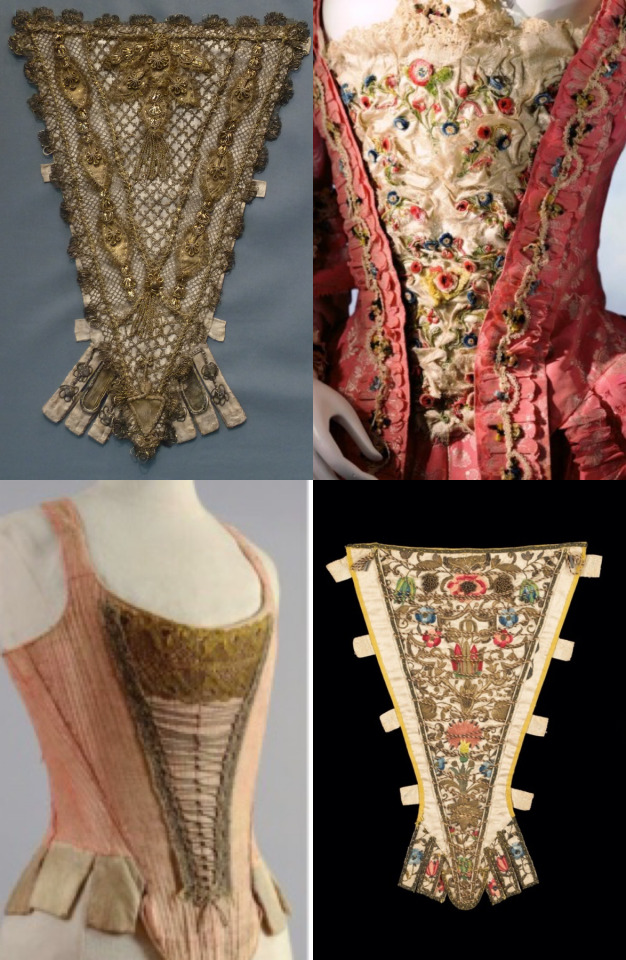
The other main issue I mentioned are the sleeves. Eleanor is the biggest offender of this, while Miranda (who overall has the most accurate outfits) never seems to have this issue. Sleeves of the time period were not tight. They ended just below the elbow and were either a wide bell shape, or were tight and then flared out in a trumpet shape. Both designs were to show off the lace of their chemise underneath (once again, see my post on prostitutes). Many of the dresses in Black Sails feature long, straight sleeves that end either at the wrist or just below the elbow (and I personally blame the 2004 Marie Antoinette film for starting the trend of 3/4 length tight sleeves on 18th century gowns).
I mentioned Miranda has the overall most accurate outfits, which especially holds true for her Nassau gowns. The colors are very correct - pastels were favored in this time period, and she has the wide bell shaped sleeves that show off her white chemise underneath. When she’s at home, we often see her in a very loose mantua (known as a robe à la française or a sack back gown, which was worn in many different styles and many different circumstances), a popular choice for more informal wear. She’s also the only women who we ever see wearing a lace covering on her hair, a very accurate look.
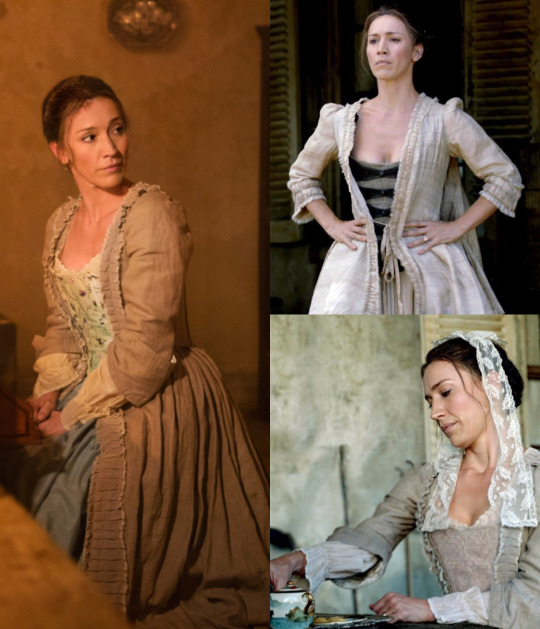
In London, we see her wearing a very different style, though still very accurate. Despite the fact that these scenes take place 10 years prior to the show time period, fashion did not change drastically between 1705-1715. Her mantuas in London are not open front, and make up the entirety of her dress. Though the draping of the fabric on the bodices makes them appear more rounded, they do in fact have the same conical, pointed shape that was popular during the period. Her silks would have been very accurate for a noblewoman in London, however the color is completely wrong - she would have been wearing pastel silks, with perhaps a bit more decoration.
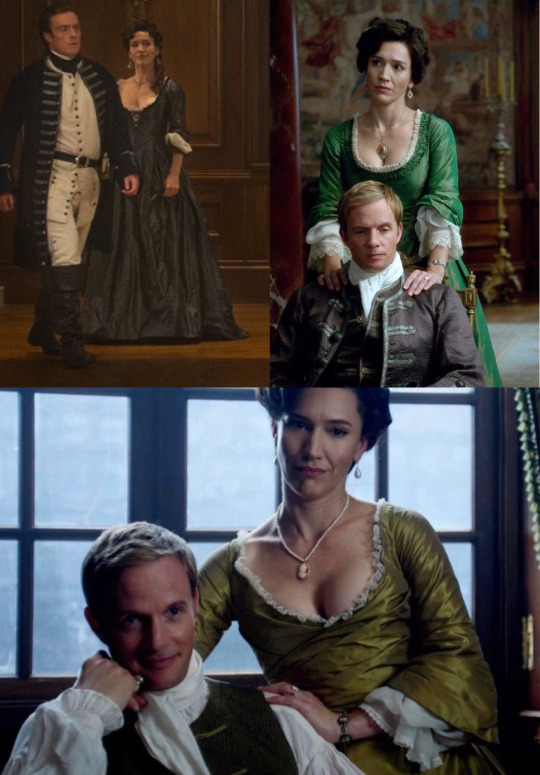
Eleanor Guthrie-Rodgers in seasons 3 and 4 shifts from wearing her pirate garb to the dresses of the ladies of London. Her and Mrs Hudson wear practically identical styles of dresses, with identical inaccuracies. There are quite a few things wrong with her dresses. As mentioned before, she is the worst offender when it comes to sleeves, at no point does she ever wear historically accurate sleeves. She is also the worst offender when it comes to the incorrectly attached stomachers, and while she does have one or two paler dresses, she mostly wears jewel tones as opposed to pastels. That being said, I am a fan of the style of her manutas. The tighter bodice with the pleated skirt is what was known as a robe à l’anglaise or a close bodied gown, and what I like about them is that the mantua is all one gown. To explain, at first glance I thought they had made Eleanor’s bodices seperate pieces from her skirts, which is often what period costumers do when they want the appearance of a close bodied gown while cutting some corners. However, to my delight upon closer inspection, every one of Eleanor’s gowns is a full mantua with a visible waist seam and very accurate pleating on the skirt. It’s a shame the designer went to painstaking lengths to get this one detail accurate, while leaving the sleeves and stomacher as incorrect as they are. It’s interesting to note that her grandmother wears a very similar style to her (though her sleeves are a more accurate shape).
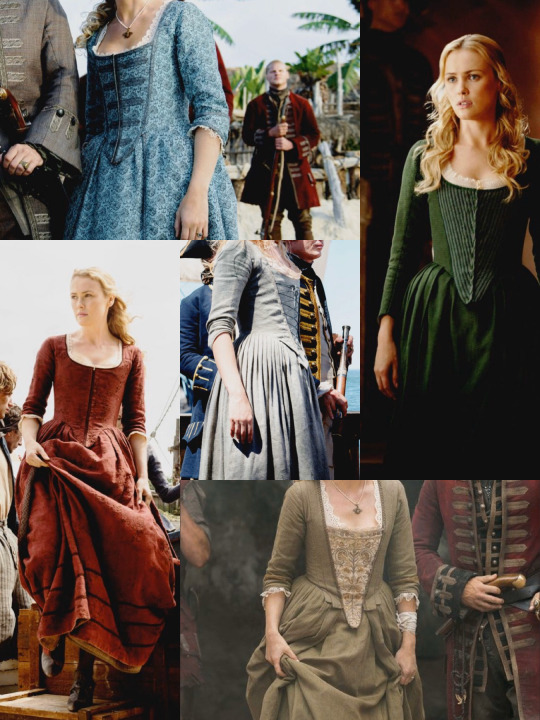
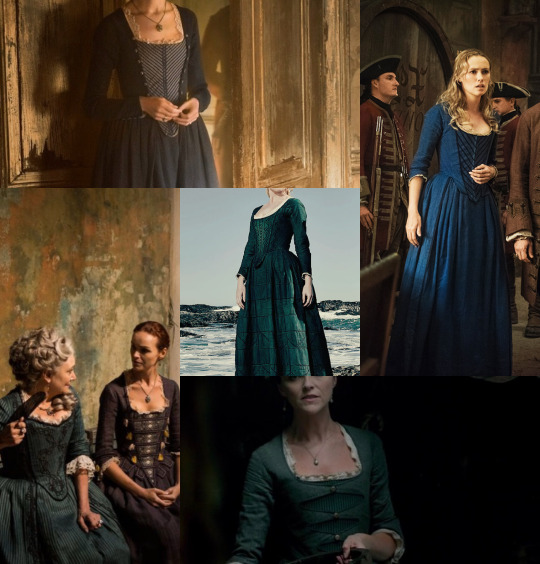
This is getting very long and we haven’t even started talking about the fashion icon that is Max! Max wears probably the most outfits of anyone on the show, which means that her costumes vary wildly from having very accurate details to very inaccurate ones. She wears some gorgeous mantuas, but some of her dresses have seperate bodices from skirts (as mentioned with Eleanor); some of her sleeves are wider bell shapes and some are straight and narrow; many of her very accurate stomachers are very inaccurately attached; while she wears some accurate colors and decorations, many are very modern or a much darker color scheme than would have been seen during that time period. For that reason rather than going into her overall look, I’m going to include pictures of her and simply add labels discussing each outfit to the pictures so you can see how overall she is a blend of accurate and inaccurate.
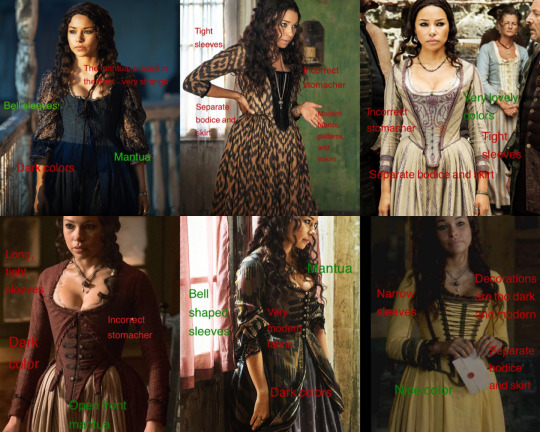
(Dress 1, top left: Bell sleeves and a mantua, however the mantua is laced in the front, not something that normally would have been done, and the dress is very dark. Dress 2, top middle: Tight sleeves, a separate bodice and skirt, incorrect stomacher, and modern fabrics, patterns, and colors. Dress 3, top right: Incorrect stomacher, a separate bodice and top, and tight sleeves, however the colors and decorations are lovely. )
(Dress 4, bottom left: A very nice open front mantua with a light petticoat, unfortunately there is an incorrect stomacher, tight sleeves, and very dark colors. Dress 5, bottom middle: A mantua with bell sleeves, however it is a very modern fabric in very dark colors. Dress 6, bottom right: Narrow sleeves, a separate bodice and skirt, and very dark modern decorations, but the color is very nice.)
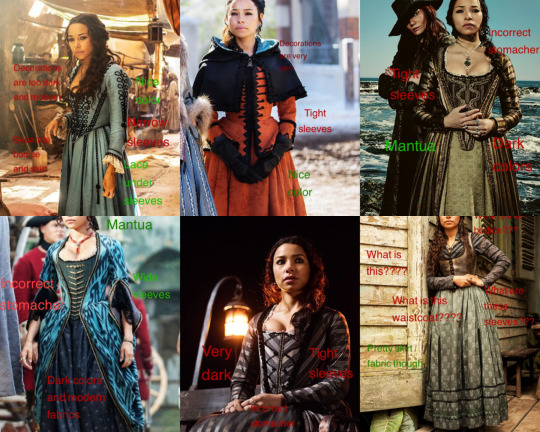
(Dress 1, top left: Nice color with a lace chemise under the sleeves, but the sleeves are narrow, the skirt is separate from the bodice, and the decorations are very dark and modern. Dress 2, top middle: A mantua in a nice color, but with very dark decorations and tight sleeves. Dress 3, top right: She is wearing a mantua but it has an incorrect stomacher, tight sleeves, and dark colors)
(Dress 4, bottom left: A mantua with wide sleeves, an incorrect stomacher, dark colors and modern fabrics. Dress 5, bottom middle: Very dark with tight sleeves and an incorrect stomacher. Dress 6, bottom right: What is this??? What is this bodice??? What are those sleeves??? What is that waistcoat??? A pretty skirt fabric though)
As I did with the prostitute post, I’m going to end this with mentioning my personal favorite dress of this style in terms of accuracy - Abigail Ashe. Exactly the right color, a very pretty mantua with a perfect amount of decoration for someone of her monetary situation, and while the sleeves are a little too tight for my tastes we can clearly see the lace of her chemise underneath. All in all, very lovely.
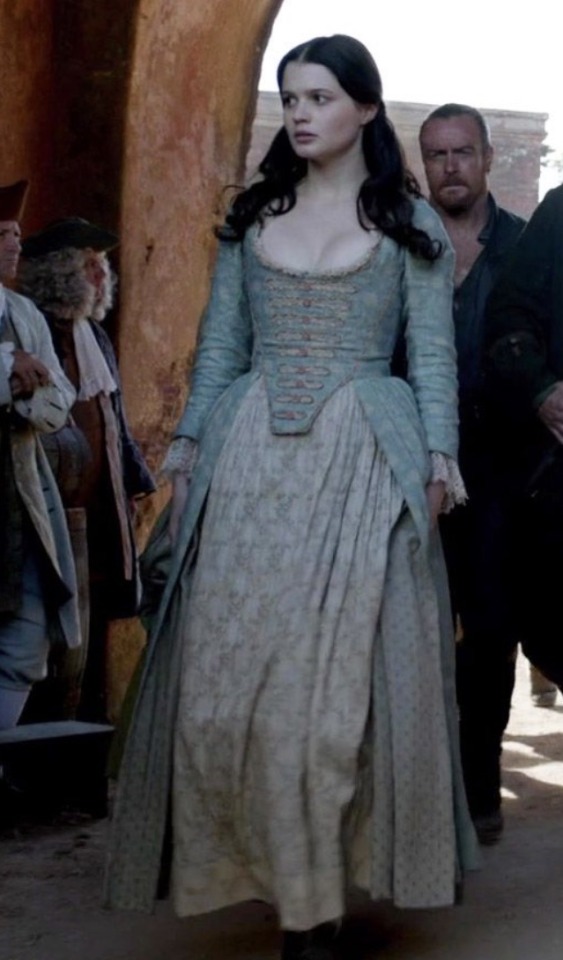
#black sails#black sails costumes#black sails fashion#abigail ashe#eleanor guthrie#black sails max#bs max#madame guthrie#mrs hudson#miranda barlow#miranda hamilton
106 notes
·
View notes
Note
(9) In summary, when things get hard, does Silver go back to what he knows: being out for himself, lost in creating his “perfect” life, even if it means losing the person who loves him/he loves, all stemming from his repression in realizing his feelings, in repressing his past, an inability to stand being truly seen, and therefore an inability in being an honest, equal partner?
Alright, my dude, you’ve got me doing a deep dive on this one haha. I actually went back and re-watched the last three episodes and took notes to sort all this out in my head. Hopefully it all makes sense. This is all about Flint and Silver’s motivations and the actions they take to achieve their goals towards the end of the series. It’s gonna be a long one, so buckle in. As Jack Rackham once said: “Please forgive me, I will go on from time to time, but generally in the service of thoroughness...” I’m gonna post this under the last of your asks, as I believe it addresses most of your points. If I leave anything out please let me know.
Alright so, *crack knuckles* here we go:
For context: Rackham and Max have gone to create an alliance with Marion Guthrie in Philadelphia, Billy has gone to Rogers to show him how to divide Flint from Silver, and Madi has been taken prisoner.
Early in episode 8 we get the first of a number of similar conversations between Silver and Flint concerning the war. This one has Silver asking what’s going to happen after their current conflict. He points out that any time Nassau hasn’t had a someone to lead/support it (Eleanor, Rackham, Rogers) it becomes a place of horrors. If this is meant to be a period of transition, what’s on the other side? Something better, something meaningful? He asks:
‘But what if it isn't? What if the result of this war isn't beyond the horror, what if it is the horror itself. Have you given this any thought at all?’
To which Flint replies that to be rid of England and fashion something else, he knows that they will have to go through a period of darkness and seeming hopelessness. But that he has to believe that it will be worth it and that progress is possible. Silver responds by saying that’s a lot of potential suffering to wager on blind faith. Flint assures that with the right people in place they can get through it. He also states that those people are meant to be Madi and Silver, and that Madi is just as important to realizing their goals as the cache.
So Silver agrees to try Flint’s plan to retrieve Madi, but he still brings the treasure along just in case this all goes sideways. And it does. Rogers just starts shooting people willy-nilly which even Flint seems surprised about. Just as Rogers is about to blow Madi’s head off, Silver shows him the chest and next thing we know we’re on our way to Skeleton Island to make the exchange. On the way there Flint yells at Silver about how he’s just given Julius more leverage against the cause and crippled the war effort. Silver retorts by telling Flint that they’ll make do somehow and demands his support in this venture. He points out the numerous times he’s helped Flint even though he didn’t necessarily understand or agree with him.
‘My god. The number of times I have followed you blindly, backed you with the men blindly, put men in the fucking ground…good men! Friends! Because you said, “I know the way. "Don’t ask me how. Just do as I say.”’
Silver asks again if Flint will support him and Flint answers: “Yes.”
Shortly after this we have two great conversations happening in parallel: Silver with Hands and Flint with Dooley. Hands tries to convince Silver that Flint is Bad and must be killed. Silver asserts that he trusts Flint. Hands says that a crown can’t be split two ways and that he knows that Silver actually wants Flint dead, he just doesn’t know how to ask for it. To which Silver responds:
‘Hear me very clearly, there is no hidden message and no equivocation, you will make no move against him, you will not speak of doing so to any man on this crew nor to me again. Do it, and you'll answer for it.’
Meanwhile, Flint is telling the legend of skeleton island to Dooley in order to bring up the subject of men loosing their wits. He asserts that he believes Silver is compromised and so he (Flint) finds himself in need of a new partner. Dooley agrees and they go to fetch the gold, almost getting killed by another crew member in the process. They are saved by Hands who tells Flint he wants them to go ahead and take the treasure so that Silver will see Flint’s true colors. The end of the episode has Silver witnessing this betrayal and deciding to send men out after Flint, ostensibly to kill him, though I think he knew those men were not a match for Flint and really just wanted to find out where he was going so that he could get the treasure back.
In a fit of true diabolical evil, our writers chose to follow up this last scene from episode 8 by opening episode 9 with the first flashback of Flint and Silver’s fencing lessons. I literally said “Oh, no” to myself several times aloud as I watched Silver climb that hill to the bluffs.
Now these are lovely scenes I could go on about forever, but the most important takeaway for me right now, is that Flint realizes he doesn’t know anything about Silver’s past. Silver says that his past isn’t important. Flint argues that that’s not true. From Flint’s perspective, he’s revealed himself to Silver, given him his history, which defines him, and also the tools Silver needs to guess at Flint’s future actions. Flint goes on to insinuate that Silver wormed his way into Flint’s story by comparing himself to Flint’s former ill-fated partners. That he did this in order to use Flint’s affection for him to make it more difficult for Flint to act against him later. Silver is disquieted by Flint calling his bluff and seems thrown by that last comment in particular, mostly because I don’t think Silver consciously meant to manipulate him that way at all. Flint says he’s not angry with him but Silver is too overwhelmed to continue. He asks if it’s okay if they resume tomorrow, and flees.
I want to revisit the fireside chat here for a moment in order to point out that Silver was, in fact, already very deeply in the story by that point, a story he’d been made a part of largely against his will (by his injury, by Flint’s machinations, by Billy, etc.). In regards to Silver’s motivations during that conversation, I always assumed them to be exactly what they seemed to be: He wanted to understand why Flint was so driven to wage war and he wanted to voice a real, actual warning that he himself might prove to be Flint’s undoing. Flint responds in a way that makes me think he either A. didn’t think Silver would betray him or B. he didn’t think that Silver could get the better of him.
This is an important moment of dissonance between them, because it repeats itself in the sword lesson flashback: Silver asks if Flint is worried about the fact that he’s essentially teaching Silver to best him in combat and Flint waves him off with a smile, saying he’ll take his chances.
The most significant moment within the flashbacks comes when Silver finally finds the words to outline his philosophy and frame his decision not to share his past. I actually think this scene gives Flint all he needs to know about Silver as a person (in terms of being able to anticipate Silver’s future actions), though I’m not sure in that moment he could really wrap his head around it. Knowing the details of Silver’s past are not necessary when you realize that they did, in fact, define him and one can use that knowledge to recognize the ways in which they shape his future decisions.
Silver maintains that he is not trying to hide anything, he merely absolved himself from the obligation of finding any relevance in his own story because there is no coherence, ‘nor sense, nor grace’ to be found in life. But more than that it’s because he’s experienced ‘events some of which no one could divine any meaning from, other than the world is a place of unending horrors.’ He says that Flint knows of him all that’s relevant to be known and swears that Flint has his true friendship. He asks if it is enough for there to be trust between them and Flint, not quite sure what to make of all this, answers by resuming their lesson.
Intermixed with these flashbacks are our real-time scenes, some of which I want to touch on to check in on Silver and Flint’s states of mind. As Silver and Hands pursue Flint in the forest, Hands asserts that he believes Silver will keep finding reasons to forget everyone’s warnings about Flint. He also mentions when Silver tells the men to split up to find Flint that he’s sending at least one group of them to their deaths. Hands makes a point of saying that Silver’s decision here shows that he’s learned a lot from Flint. Aka, Silver is willing to sacrifice other’s lives to reach his own ends. Silver seems uncomfortable with the comparison, likely because he sees the truth in it. Silver’s desire to not be like Flint is very important in the final moments of the show and will come again up later. Silver admits to Hands that he’s not sure if Flint actually wants to save Madi for the sake of it or if it’s just part of his larger machinations. It’s key to note that Silver’s trust in Flint is degrading further. Both because of Silver’s inherent pessimism, and because of Flint’s own actions.
Meanwhile, Flint and Dooley are doubling back to the chest after having chucked it over an embankment to throw Silver’s party off their scent. Dooley essentially tries to convince Flint that Silver might become a liability. Flint defends Silver but Dooley’s like, yeah, but if it comes to it I’ll kill him for you. The look on Flint’s face clearly shows how not okay he is with the thought of Silver dying, but he keeps his reservations to himself for now. At this point, it is important to acknowledge that neither Silver nor Flint wants the other dead. They are both still trying to outmaneuver each other in order to reach their goals.
Silver finally catches up to Flint which leads us to another Important Conversation wherein Silver states that if the war were to continue it would be just like this, forever - lies, betrayals, death. He also tells Flint that he understands Flint’s motivations more fully now because he’s suffered a similar loss. When Madi was presumed dead, he wanted to give her sacrifice meaning by waging battles in her name. But he says that underneath that desire was the thing that Flint himself taught him to recognize: rage. In a very Miranda moment, Silver tells Flint that part of what drives him is wanting to watch the world burn. This is another way in which Silver does not want to be like Flint.
After this is a deeply depressing flashback wherein Silver is trying to explain his relationship with Flint to Madi by saying: ‘I have earned his respect, after all the tragedies that man has suffered (...) I have earned his trust, I have his true friendship. And so he's going to have mine. And as long as that is true, I cannot imagine what is possible.’ And all of our hearts break a little to think of what could’ve been. Because, as I mentioned before, Silver no longer believes he can trust Flint and so he no longer has faith in their friendship.
The episode ends with Rogers blowing up the Walrus which puts a hold on Flint and Silver’s duel and forces them to ally once again with Rackham. Flint makes a little speech about how their priority is to rescue Madi and tells Jack he’s taking over command of the ship to facilitate that end. The next episode starts with Silver questioning Flint’s motives, sure that he’s only placating John whilst continuing his scheming. Flint throws him by offering a very candid and heartfelt reply about how he isn’t sure he wouldn’t have acted exactly as Silver had if it were Thomas’s life on the line. He states that he meant it when he promised he’d see John through this and still wants to put things back together. Silver is visibly torn over whether or not he believes what Flint is saying.
Alright, we can now fast forward to the Final Confrontation. Flint, realizing that something has passed between Silver and Jack that smacks of betrayal, halts their trek through the woods in order to question Silver about it. Silver can’t bring himself to lie. He asks Flint how much more ‘measuring of lives and loves and spirits’ there will be ‘so that they may be wagered in the grand game. How many casualties can be tolerated for the cause, how much loss?’ So it’s not just Madi’s life he’s concerned for, not just his own or Flint’s. He mentions the men, women, and children who have already died for this, who will continue to die for this. And he cannot see where the line might be, because Flint has yet to draw one - this is a man who frequently endangers himself, killed his best friend, sacrificed crew members, murdered innocent civilians, and has no qualms betraying his allies. I think Silver legitimately believes that Flint will stop at nothing. That’s why it’s not a war to Silver, not like any other, instead it’s a ‘fucking nightmare.’
When Flint insists that Silver stopping the war will mean that they will have been for nothing, that this is how the powers-that-be win, that they’ll be distorted to fit false narratives, Silver asserts that he doesn’t care. I personally don’t find this surprising at all, given how little Silver cares about his own personal narrative. I also don’t think that Silver Doesn’t Care At All, it just means that he doesn’t care enough for it to change his mind. I mean he’s lost a leg for these people, risked his life and freedom for this cause, allowed himself to be molded into a better partner for Flint. When Silver opened himself up to a partnership/friendship with Flint and later to a partnership/romance with Madi, he was choosing to allow meaning back into his life. He became a part of a story. But he’s not totally invested in the story itself. He’s mostly just invested in the people in it. Because what does it matter what strangers say after he’s dead? Life up to this point has been about grabbing onto whatever you can in the moment and enjoying it until it is inevitably taken away from you. Experience has relentlessly taught him to have low expectations. So while I think he cares about his relationship with Flint, is proud of what they were able to achieve together, would like to change the world for the better, and wants to be worthy of Madi, none of those goals/states of being are as achievable to him in this moment as ending the war.
I’m not sure that Silver believes that a “good life” with Madi is possible after this - Flint points out that she won’t forgive him for taking the war away and I think Silver knows that’s true - but he’s willing to go for some kind of reconciliation at least. I also don’t think Silver is factoring a post-conflict relationship with Flint in at all - as far as he’s concerned either Flint will be safe somewhere far away with Thomas or Silver will be forced to kill him.
This leads us up to the ending. I personally don’t believe that Silver killed Flint. I feel that’s an important distinction to make when trying to make sense of Silver’s decisions. I won’t go into all the reasons I believe this, in the interests of keeping this thing under ten thousand words, but I will mention a few.
Firstly, as I mentioned above, I think that Silver honestly didn’t want to turn into Flint. When Madi say she thinks he’s lying about not murdering Flint, Silver says that he’s not the villain she fears he is, he’s not him. I think this is in reference to Flint killing his friends to further his goals. I also believe that Silver thought that giving Thomas back to Flint was the key to Madi’s forgiveness and so I think he would have done it for real in case she ever checked up on it. However, I do also think that Silver embellished the story of Flint’s reunion with Thomas. What parts were true and which were false, who can say? He just sounds like he’s dressing up the story a bit, both for Madi’s sake and for his own.
The second main reason why I think Silver’s story checks out actually involves Rackham. Jack tells Marion Guthrie that Flint has retired. Why would he lie about that when telling her Flint was dead would more thoroughly assuage her concerns? He mentions that Flint retiring was a better story to sell the Maroons, but at this point, the treaty has already been signed, so why keep up the fiction?
The third and most tenuous thought I have about it is that Silver uses his “I’ll wait a day, a week...” etc. line on Madi because it actually worked previously on Flint. Maybe some of Flint’s anguish in the woods is over the fact that he’s going to do what Silver’s asking him to do. Maybe he doesn’t want Silver to have to kill him so he gives in and gives up his war.
In conclusion, and to answer one of your questions directly, I think that characterizing Flint as someone who just wants to sate his rage is just as limiting as characterizing Silver as someone who just wants to take the easy way out. And I think that saying that Flint’s motives for reforming the world were noble is as incomplete as saying that Silver just wanted to save the ones he loved at the cost of everything else. All of those things, and more, are simultaneously true.
For me, Flint and Silver were both bad men and good men. Both had room to grow. Both made choices for each other. Both manipulated each other and made mistakes. Both were forced to make quick decisions under enormous amounts of pressure. They were both angry and afraid and courageous and loyal and deceitful and kind. They were both very very human.
It might not seem like it, but I’m more of a Flint irl. Maybe that’s why I’ve tried so hard to understand Silver, because his motivations were a bit more foreign to me at first. I’ve come to love and sympathize with both of them - which is why I continue to talk about them incessantly and devour fan works - especially the ones that get these two to finally work out their issues. If you’re ever looking for fic recs, btw, please do let me know. A lot of this meta is fleshed out beautifully in fan fiction. And those authors say it more profoundly and elegantly than I could ever hope to.
#james flint#john silver#Black Sails#black sails meta#hoo boy it's a long one folks#black sails s4#this is practically a play by play
22 notes
·
View notes
Photo

For the week of 28 October 2019
Quick Bits:
Afterlift #1 is a digital original from Chip Zdarsky, Jason Loo, Paris Alleyne, and Aditya Bidikar. Very interesting concept here playing with a character who drives for a Lyft analogue in Cabit, leading to becoming a rather unique courier.
| Published by Jams & Jellies

Batman Annual #4 actually gives us many adventures and stories as we go through almost two months’ of diary entries of Batman’s exploits from Alfred, as told by Tom King, Jorge Fornés, Mike Norton, Dave Stewart, and Clayton Cowles. It’s a nice way to pack a lot of story into this annual in a fairly unique way, while also showcasing just how busy Batman really is.
| Published by DC Comics

Black Panther #17 sets up for the next confrontation with N’Jadaka and his forces, also giving us a rather...awkward but interesting conversation between Storm and Nakia. Gorgeous art from Daniel Acuña.
| Published by Marvel

Bloodshot #2 continues the balls to the wall action as Bloodshot and the Black Bar conflict escalates, from Tim Seeley, Brett Booth, Adelso Corona, Andrew Dalhouse, and Dave Sharpe. It’s a bit of a throwback to a more action-oriented style, but it definitely works for Bloodshot. A nice change of pace to give a variety of storytelling.
| Published by Valiant
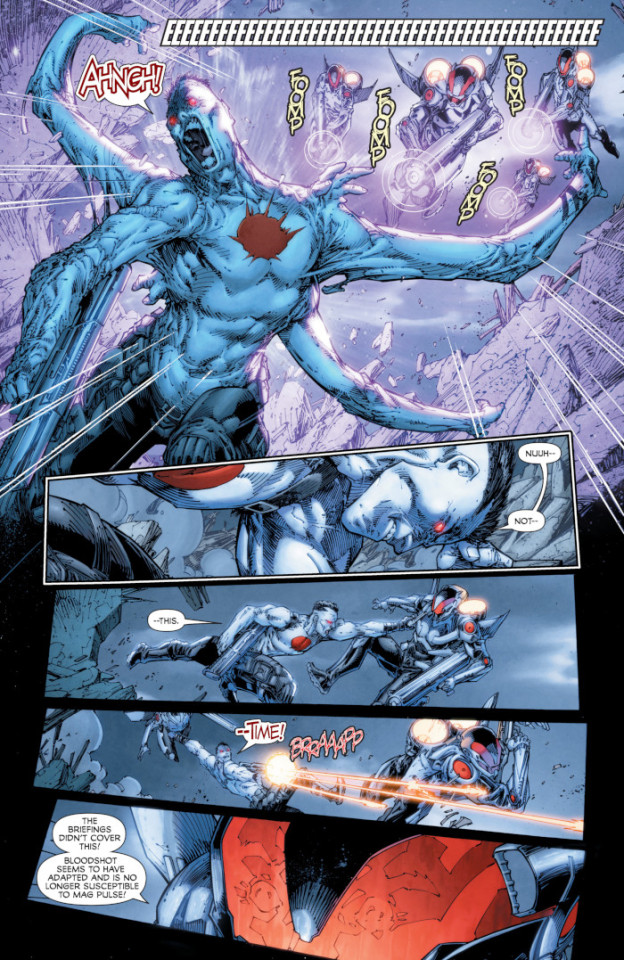
Conan the Barbarian #10 spins us the twins’ yarn as they plotted their revenge on Conan, from Jason Aaron, Mahmud Asrar, Matthew Wilson, and Travis Lanham. The art from Asrar and Wilson is gorgeous. The backstory building up to last parts of this story and the fate of Conan is gripping.
| Published by Marvel
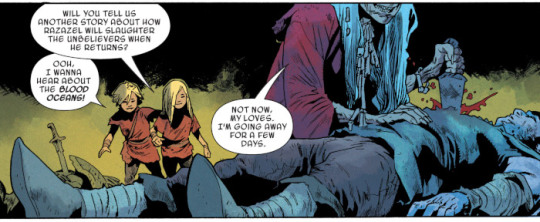
Contagion #5 brings an end to this series from Ed Brisson, Adam Gorham, Veronica Gandini, and Cory Petit. Gorgeous and creepy art here from Gorham and Gandini.
| Published by Marvel
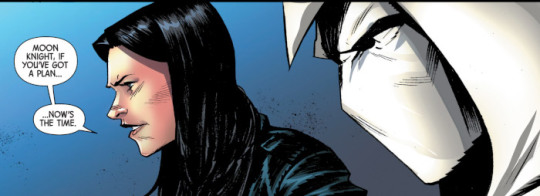
DCeased #6 is surprisingly hopefully, even as everything dies and everybody hurts. It appears to be setting up a sequel, though likely to be incredibly bleak. Tom Taylor, Trevor Hairsine, Neil Edwards, Stefano Gaudiano, Rain Beredo, and Saida Temofonte conclude this series in epic fashion as we say goodbye to Earth.
| Published by DC Comics

Death’s Head #4 is another ending to a series this week, from Tini Howard, Kei Zama, Felipe Sobreiro, and Travis Lanham. Some very nice character work here for Death’s Head and Vee.
| Published by Marvel
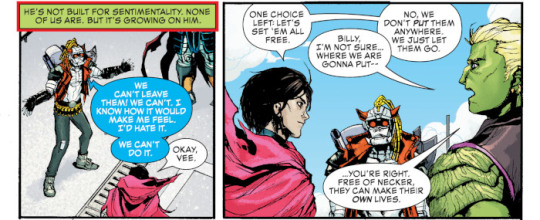
Doctor Strange Annual #1 gives us a pair of tales. The lead from Tini Howard, Andy MacDonald, Tríona Farrell, and Cory Petit is a fun Halloween story dealing with the spirits haunting the Sanctum Sanctorum. Any art from MacDonald is a treat. The back up is a bit more deadly serious with Pornsak Pichetshote, Lalit Kumar Sharma, Sean Parsons, José Villarrubia, and Petit revealing a failsafe should Strange go rogue.
| Published by Marvel
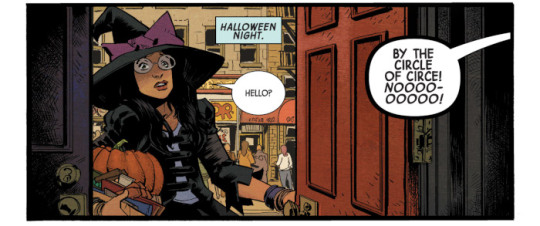
Ether: The Disappearance of Violet Bell #2 continues to be incredibly inventive as Boone tries to track down the assassin. David Rubín’s art is absolutely amazing. And Boone’s continued inability to really think about anyone other than himself is telling.
| Published by Dark Horse

Excalibur #1 is another tick in the win column for “Dawn of X”. The X-Men dabbling in magic isn’t common, but Tini Howard, Marcus To, Erick Arciniega, and Cory Petit do so with amazing flair, fittingly taking us in through Otherworld, Captain Britain, and Betsy Braddock. Apocalypse’s new incarnation as “ •|A| •” and his newfound interest in magic is fascinating.
| Published by Marvel

Five Years #5 spotlights Zoe’s rather elaborate imagination for coming up with ways to murder people. Granted, the Russian agent may well deserve it, but still... Terry Moore continues to deliver some unexpected twists as the end of the world inches closer.
| Published by Abstract Studio

Giant Days: As Time Goes By #1 is a one-shot finale special from John Allison, Max Sarin, Whitney Cogar, and Jim Campbell. It picks up roughly a year from the end of the series, dealing with why Esther has been missing from their reunions. It’s full of all of the humour that we’ve been used to and hammers home the power of friendship. Also, it gets very, very weird.
| Published by Boom Entertainment / BOOM! Box
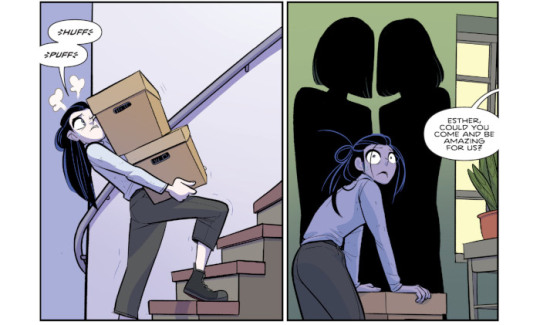
Harleen #2 works hard to portray Harley’s seduction by the Joker. Stjepan Šejić and Gabriela Downie portray it as an insidious, manipulative thing. It might appear romantic on the surface, but there’s definitely a darkness there. There are ideas of bringing back a monster from the edge of insanity, but the story makes you realize that some may well be beyond hope.
| Published by DC Comics - Black Label
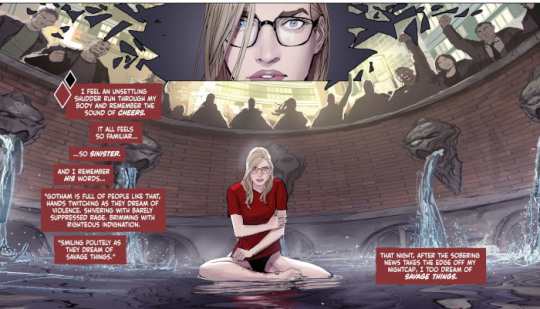
Hellboy and the BPRD: Long Night at Goloski Station might well be the best of these new format tales yet, and both of the previous ones were incredibly strong. Here Mike Mignola, Matt Smith, Dave Stewart, and Clem Robins deliver a single issue story building on Hellboy’s confrontation with Baba Yaga, Sir Edward Grey, and demons.
| Published by Dark Horse

Invisible Kingdom #6 begins the second arc, “Edge of Everything”, as the crew first try to find food and fuel and then run afoul of a salvage ship. G. Willow Wilson, Christian Ward, and Sal Cipriano keep things interesting as we start to see the crew’s life after Lux.
| Published by Dark Horse / Berger Books
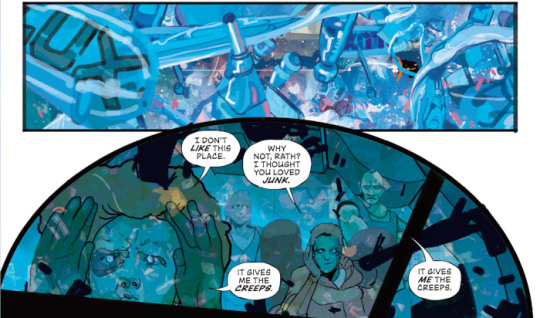
Invisible Woman #4 is disturbing, basically everything goes to hell and everyone that Sue was trusting to see this operation through has let her down. Or worse. Mark Waid, Mattia De Iulis, and Joe Caramagna set up a rather horrifying situation in this penultimate chapter. Again, De Iulis’ artwork is stunning.
| Published by Marvel
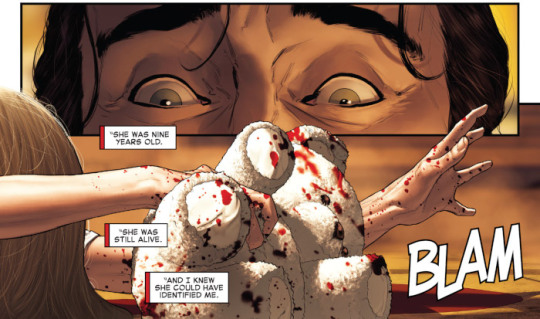
Joker: Killer Smile #1 is essentially a psychological horror from Jeff Lemire, Andrea Sorrentino, Jordie Bellaire, and Steve Wands. It comes from the point of view of a psychiatrist, Dr. Ben Arnell, who is trying to get to the heart of Joker’s mental state. It’s not going so well and it appears like the good doctor is losing time, doing strange things, and possibly worse. Very intriguing beginning to this story.
| Published by DC Comics - Black Label

Knights Temporal #4 has some stunning artwork from Fran Galán, particularly during the gangster sequences where colour comes into play as another important storytelling element. There are some very nice twists this issue, making you wonder about a lot of what we thought we knew.
| Published by AfterShock
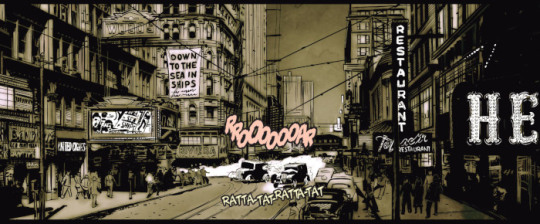
The Last God #1 is dark fantasy done right by Phillip Kennedy Johnson, Riccardo Federici, Sunny Gho, Dean White, Tom Napolitano, Steve Wands, and Jared Blando. It gives us lying kings, heroes who weren’t rightly heroes, and a Lovecraftian terror returned to show the truth. It plays deep on resentment and distrust, and of a complete failure of institutions to uphold a decent society. All with absolutely stunning artwork from Federici, Gho, and White. This is a beautiful, haunting work.
| Published by DC Comics - Black Label

Last Stop on the Red Line #4 is very, very weird. We get a peek behind the masks of the monsters and it’s even stranger. There’s a very interesting mix of symbolism and the supernatural where we’re really not sure where one begins and the other ends. This was a very unique series from Paul Maybury, Sam Lotfi, and Adam Pruett.
| Published by Dark Horse
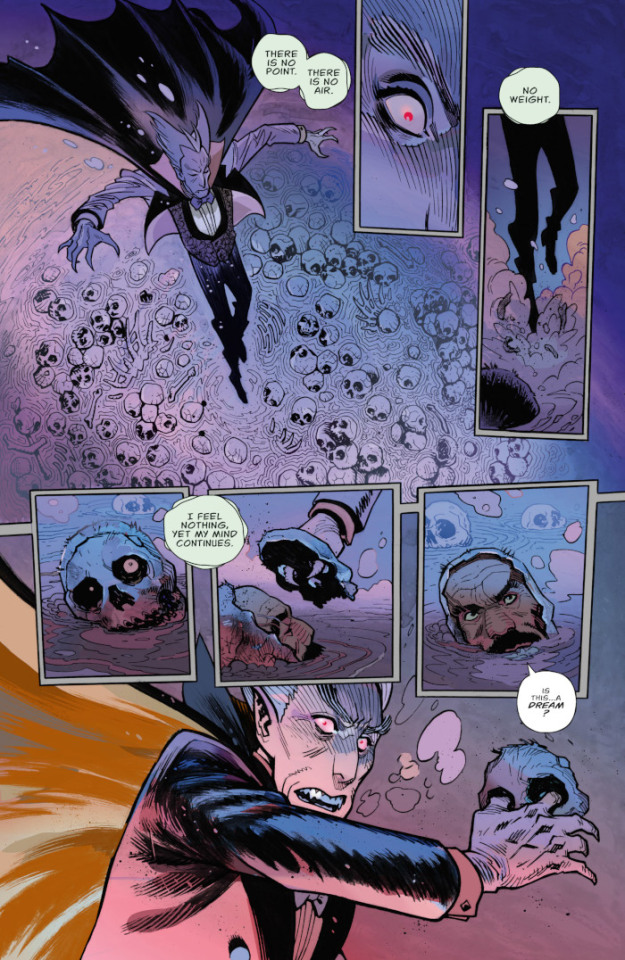
Mall #3 goes even harder into inter-faction warfare as it seems like all of the groups are at one another’s throats. Great world-building here from Michael Moreci, Gary Dauberman, Zak Hartong, Addison Duke, and Jim Campbell, with some interesting plot developments.
| Published by Vault
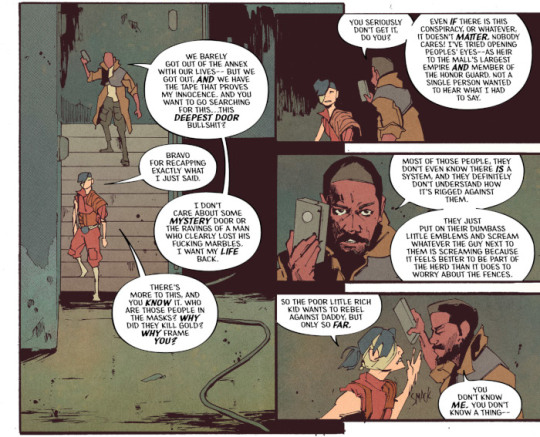
Manor Black #4 concludes the series as we see what essentially amounts to order vs. chaos as the old blood takes on wild magic. This doesn’t feel so much as a conclusion as an end to a chapter of a wider arc, leaving much unresolved. Hopefully we see more. The artwork from Tyler Crook is phenomenal.
| Published by Dark Horse

Marvel Zombies: Resurrection #1 is really damn good. Phillip Kennedy Johnson, Leonard Kirk, Guru-eFX, and Travis Lanham kick off this series with a new angle on the Marvel Zombies, playing up more on the horror angle, with a truly terrifying spread of the disease through a new vector. Gorgeous artwork from Kirk and Guru-eFX.
| Published by Marvel
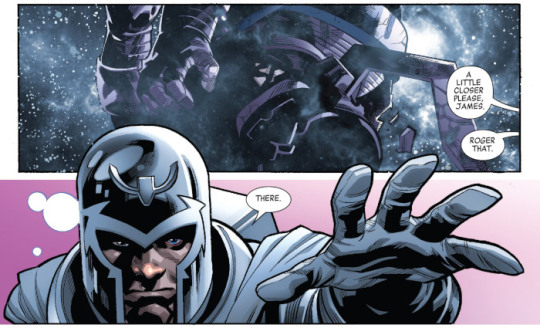
Monster Planet #1 is the kind of thing that you used to see regularly published by Image and Top Cow, the military action comic that throws in horror elements, from Joe Brusha, Marcelo Mueller, Maxflan Araujo, and Taylor Esposito. It’s not bad, setting up a world where humanity has been turned into dinosaur-like beasts and the remnants of society need to turn to classical monsters for help.
| Published by Zenescope
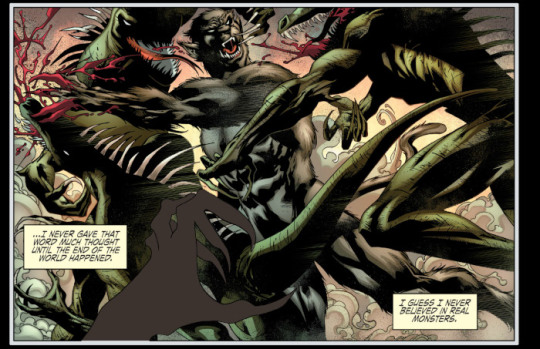
The Necromancer’s Map #3 takes a bit of a different approach, giving us a fair amount of action as Tristan’s Will catch up with Bethany and co. as well as some great character building in between the action. Great stuff from Andrea Fort, Michael Christopher Horn, Sam Beck, Ellie Wright, and AndWorld Design.
| Published by Vault
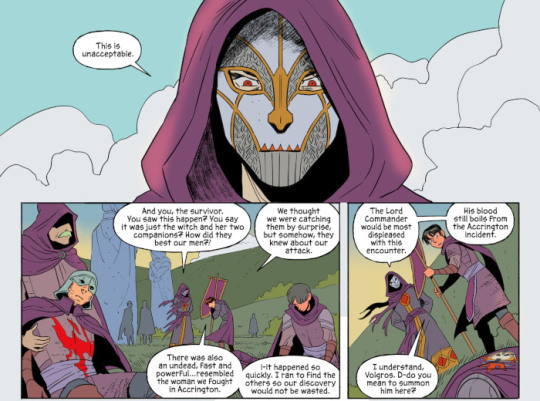
The Plot #2 is wonderful horror storytelling from Tim Daniel, Michael Moreci, Joshua Hixson, Jordan Boyd, and Jim Campbell. Very creepy build of supernatural events once Chase Blaine and his family arrive back at his ancestral home. Hixson and Boyd’s presentation of the black, gooey masses are also disturbing.
| Published by Vault
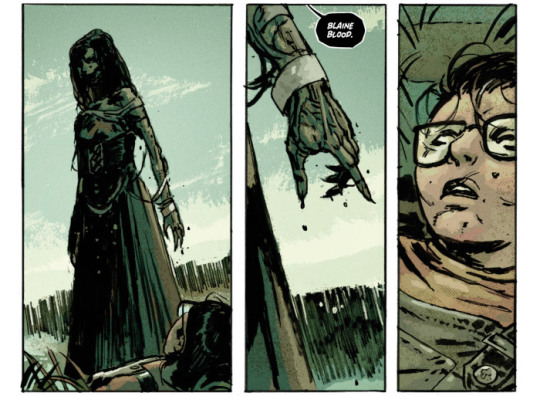
Queen of Bad Dreams #5 concludes this excellent series from Danny Lore, Jordi Pérez, Dearbhla Kelly, and AndWorld Design. Rather interesting confrontation with and revelations about Eleanor Chase here.
| Published by Vault
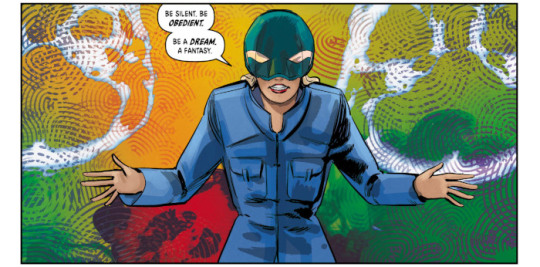
Red Goblin: Red Death #1 is a one-shot featuring three stories set during Norman Osborn’s tenure as the Red Goblin at the end of Dan Slott’s run on Amazing Spider-Man. It’s kind of weird that it doesn’t instead tie-in with current events in Absolute Carnage, but it’s not bad for what it is. The art of the first two stories from Pete Woods is great.
| Published by Marvel

Relics of Youth #2 is even better than the first issue, delving deeper into the mysterious tattoos that the kids have been branded with and their connection to the island that they’ve landed on within the Bermuda Triangle. Matt Nicholas, Chad Rebmann, Skylar Partridge, Vladimir Popov, and AndWorld Design are telling a very compelling adventure here.
| Published by Vault
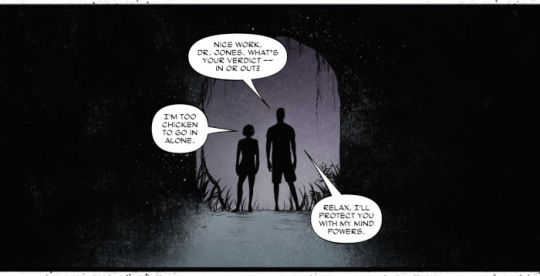
Roku #1 begins another mini-series focusing on one of the luminary villains in the Valiant Universe, this one from Cullen Bunn, Ramón F. Bachs, Stéphane Paitreau, and Dave Sharpe. It’s full of action and intrigue as Roku is hired by an unknown client to retrieve...someone. Things get more interesting as a new face stands in her way and we find out the unusual nature of the target.
| Published by Valiant

The Sandman Universe Presents: Hellblazer #1 is a homecoming of sorts for John Constantine, back to his old haunts alongside some of the other Vertigo corner of the DC Universe. Si Spurrier, Marcio Takara, Cris Peter, and Aditya Bidikar spin a yarn that reconstitutes John after a massive magic war led by an evil Tim Hunter. How exactly the pieces fit are anyone’s guess, but it’s a brilliant darker take resetting him here.
| Published by DC Comics - Black Label / The Sandman Universe

Savage Avengers Annual #1, though largely a self-contained story, is still integral to Conan’s adventure through the Marvel universe and the overall narrative as he, Hellstorm, and Black Widow stumble across a human trafficking ring that bears the marks of Kulan Gath. Gerry Duggan, Ron Garney, Matt Milla, and Travis Lanham deliver a compelling story.
| Published by Marvel

SFSX #2 does further world and character building, showing us just how much has changed since the Party took over, and how utterly betrayed many of the people from the Dirty Mind felt of Avory abandoning them. Very interesting stuff from Tina Horn, Michael Dowling, Chris O’Halloran, and Steve Wands.
| Published by Image

Silver Surfer: Black #5 concludes what has been a very trippy series from Donny Cates, Tradd Moore, Dave Stewart, and Clayton Cowles. There are some very interesting revelations of the past here, and it really makes you wonder about the Surfer’s new incarnation.
| Published by Marvel
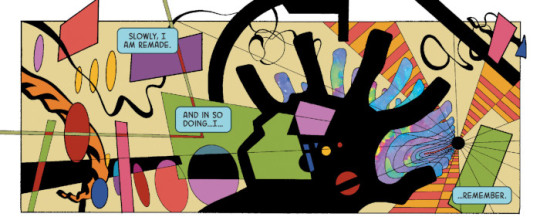
Star Pig #4 concludes the series, kind of, from Delilah S. Dawson, Francesco Gaston, Sebastian Cheng, and Shawn Lee. There’s some rather disturbing tentacles in this one.
| Published by IDW
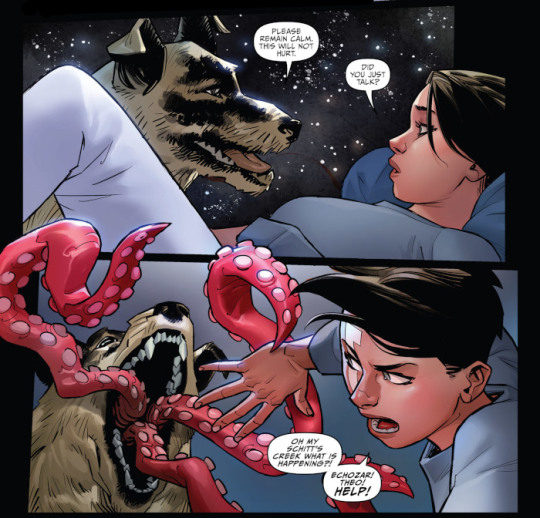
Star Wars Adventures: Return to Vader’s Castle #5 brings an end to this round of the series. I think it’s a perfect approach for some all ages “ghost stories” within the Star Wars universe. Wonderful resolution for the framing story from Cavan Scott, Francesco Francavilla, and AndWorld Design.
| Published by IDW

Tales from the Dark Multiverse: The Death of Superman #1 is the second of these one-shots spotlighting DC events gone horribly wrong, this time giving us a much angrier Lois Lane’s grief at the loss of Superman to Doomsday. Jeff Loveness, Brad Walker, Drew Hennessy, Norm Rapmund, John Kalisz, and Clayton Cowles present her as vengeance against a world that didn’t deserve Superman’s grace, raising some of the questions that you’d often see in The Authority. Only, you know, kind of evil. It’s not bad, but definitely dark.
| Published by DC Comics
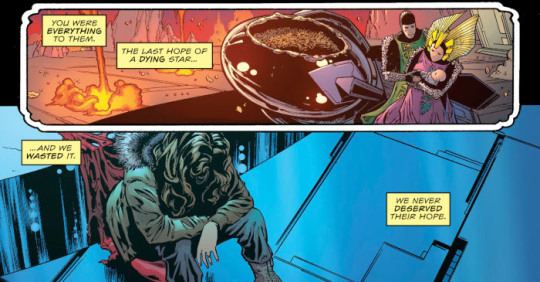
Teenage Mutant Ninja Turtles #99 is the extra-sized penultimate chapter of “City at War” as all of the pieces begin falling into place for the grand finale. The story here from Kevin Eastman, Bobby Curnow, Tom Waltz, Dave Wachter, Ronda Pattison, and Shawn Lee feels truly epic and that something huge may just happen next issue. As it is, there’s still a ton of action here, some interesting developments with the Rat King, more disappointment when it comes to Raph, and something new with the mutagenic bomb.
| Published by IDW
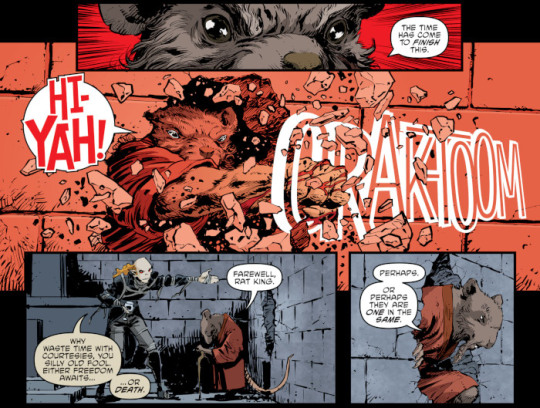
Test #5 is very strange. Christopher Sebela, Jen Hickman, Harry Saxon, and Hassan Otsmane-Elhaou end this story as Aleph and Laurel find one another and a new way is planted, but there’s still seeds of something going awry.
| Published by Vault
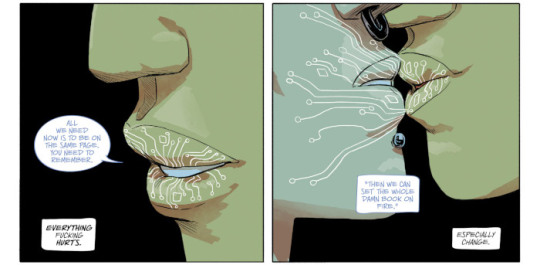
Venom #19 largely plays out the end bits for the Maker and Dylan’s portions of Absolute Carnage, with some very interesting revelations. It seems like even bigger seeds are being lain for future stories here. Great art from Iban Coello and Rain Beredo.
| Published by Marvel

Witchblade #16 gives us the fight between Alex and Haley, after a few distractions and discursions. The stakes are pretty high here and there are a few rather tense moments as it plays out. Beautiful art from Roberta Ingranata and Bryan Valenza.
| Published by Image / Top Cow

Wonder Woman Annual #3 is largely a flashback tale, set five years ago as Wonder Woman and ARGUS attempt to extract an agent sent to infiltrate Gorilla City to see the legitimacy of Grodd’s rule. What Steve Orlando, V. Ken Marion, Sandu Florea, Hi-Fi, and Pat Brosseau do with is establish a new backstory and interpretation for a very old Wonder Woman foe in a fairly interesting way that even ties in to Event Leviathan. It may strain a bit of credibility for the villainous turn, but that will largely depend on the follow-up.
| Published by DC Comics

Other Highlights: Archie 1955 #2, A Basketful of Heads #1, Batman and the Outsiders Annual #1, Chrononauts: Futureshock #1-4, Dead Man Logan #12, Fantastic Four: Grand Design #1, Fight Club 3 #10, Friendly Neighborhood Spider-Man #13, Ironheart #11, James Bond 007 #12, Jim Henson’s The Dark Crystal: Age of Resistance #2, Journey to Star Wars: The Rise of Skywalker - Alliance #4, Jughead’s Time Police #5, Kick-Ass #18, Mighty Morphin Power Rangers #44, Rick & Morty #55, The Ride: Burning Desire #5, Runaways #26, Star Trek: Year Five #7, Star Wars: Doctor Aphra Annual #3, Star Wars Adventures #27, Superior Spider-Man #2, Tremor Dose, Warlord of Mars Attacks #5
Recommended Collections: Amazing Spider-Man: Red Goblin, Amber Blake - Volume 1, Black Science - Volume 9: No Authority But Yourself, Deadpool - Volume 3: Weasel Goes to Hell, Dept H. Omnibus - Volume 3: Decompressed & Lifeboat, Dick Tracy Forever, Hit-Girl - Volume 5, Jimmy’s Bastards - Volume 1: Year One, Lucifer Omnibus - Volume 1, Marvel Action: Spider-Man - Book 2: Spider-Chase, Punk Mambo, Spider-Gwen: Gwen Stacy, Star Trek: The Q Conflict, Symbiote Spider-Man, Thor - Volume 3: Wars End, Tony Stark: Iron Man - Volume 3: War of the Realms, Vamps: The Complete Collection, War of the Realms: Uncanny X-Men, The Wild Storm - Volume 4

d. emerson eddy feels like stale, day old pepperoni pizza.
4 notes
·
View notes
Text
Books I like that no one else seems to
Rules of Engagement - I know. It’s silly. But I actually didn’t think this series was too bad. The MC was boring, that’s for sure. But some of the other characters weren’t too bad. Party Girl Sister’s story arc of going from an irresponsible college student who has yet to truly mature to a girl who understands herself and the world a little bit better was likable, at least to me. Bookish Sister’s story arc was kinda lame until she fully focused on her adventure list, though Audrey was pretty annoying. The Brother’s storyline wasn’t good, but Elena was sweet. And I like that they made the Cousin into a character with more complexity than “I’m just the jealous family member who wants all the inheritance just because, wahaha”.
Leo and William were both pretty boring LI’s, I romanced both and nothing about them appealed to me. In fact, they both felt really unrealistic. Two rich, famous guys falling for an ordinary girl the very minute they met her just because...she’s hot? Dean’s route was much better, he ended up falling for her more and more as their friendship grew, and overall, he felt considerably more human than Leo and William.
While I did enjoy books 1, 2, and 3, Newlyweds was really unneeded.
The Haunting of Braidwood Manor - It was short, but the characters were all likable, no one was annoying, and we got our first MAIN FEMALE LOVE INTEREST. People claim to have known what was behind the locked door, and maybe I’m just a gigantic dumbass, but I had no idea the Waverleys’ mother would be behind it. Eleanor was so sweet and really beautiful, and being able to choose to revive her and give her a chance to live the life she never got to was great. I also thought all the MCs in this book were beautiful. It’s a shame they never got reused.
Red Carpet Diaries, book 1 - Emphasis on book 1. Book 2 ruined Seth and Teja, pushed Matt aside and shoved Hunt (an already wildly overrated character since HWU) in our faces, and was an absolute insult to anyone who’s experienced sexual harassment/assault. But book 1 was better. Pushing the petty drama aside, the hopefulness and ambition of the MC fueled the book and honestly made me care about her. Chazz was kind of a boring best friend, not going to lie, but meeting Matt, Teja, Seth, and Gloria (my favorite!) made up for it. The worst part of the book was, in my opinion, the physical alteration with Victoria. Pixelberry changed the encounter due to copious amounts of backlash, but at one point, Victoria pulls MC’s hair (and pushes her I think, but I can’t remember) and caused her to fall through the painting. Victoria was a ridiculously toxic character (almost on Kaitlyn Liao’s level), and I feel that the only thing book 2 did right was have her appear less.
High School Story, book 3 - A lot of people talk about how much of a downgrade this book is from book 2, and I really can’t argue with that. MC caused the downfall and arrest of the corrupt principal and notorious criminal Isa in book 2 and then proceeds to become a pushover who essentially lets Brian, Kara, Max, Terrence, and Zoe walk all over them in book 3. But I liked all the interactions with the LI’s, I liked the friendship with some of the Hearst students, even though Kieran, Jade, and Cameron all turned out to be super shitty when they believed the biggest bullies (with ZERO evidence!) at their school over MC, who had been nothing but nice to them. Lastly, this was the final book with the OG crew, who got replaced with the...ugh, Class Act crew.
#choices stories you play#choices stories we play#playchoices#pixelberry#pixelberry studios#playchoices fandom#choices stories you play fandom
10 notes
·
View notes
Text
Rewatching episode 5 of season 3, and one moment I find so interesting is when max is essentially pledging her loyalty to rogers with her share of the treasure and she compares it to a dowry. There’s this reoccurring theme with Anne and max and their relationship with the idea of marriage, and the idea that turning away from it represents both turning toward their truer selves and toward each other.
With Anne it obviously comes up with the “husband” she was married off to as a child. And then her whole season 2 arc concludes with her asserting that she can’t be jacks wife. Then with max its just so telling that the moment she declares her loyalty to rogers (and loyalty to the whole facade of civilization that she still idealizes) she does so by comparing it to a marriage. And the conclusion to her entire character arc is her deciding that marrying a man is the one compromise she absolutely will not make (and I adore the face Anne makes at the very possibility of max being some man’s wife).
I feel like there’s just this really fascinating theme throughout black sails about I guess the institutionalization of love? Like, what kind of love is wrong and profane and punishable by death, and what kind of love is not only allowed and encouraged but enforced and considered legally binding, and just how harmful those definitions are (like with just how diminished Eleanor becomes playing the role of “Mrs rogers”). Its telling that the only truly healthy married couples in the entire show are Miranda and Thomas, who obviously aren’t a traditional married couple in any sense (they basically use the institution of marriage as a source of security, to shield them while they each pursue love in their own unconventional but real and genuine ways), and Scott and the queen, whose entire existence as a family is kept hidden away in the shadows outside of civilization and its laws (plus she has power that is entirely her own in a way that wouldn’t be allowed in the “civilized world” and not dependant on him, unlike Eleanor in season 4). Eleanor literally refers to playing the part of a traditional English wife as “mutilating herself”.
I just can’t get over how beautifully max’s character arc subverts the sexist “ambitious, career focused woman realizes she really just needs love” cliche. Because her realization is not “I put so much energy into my career, I failed to realize I really just need a man!” it’s “the one thing I’m not willing to do to further my ambitions is compromise my own needs and identity and marry a man”. It’s about more than just her realizing that love is more important, its her realizing that her sense of self and her sexual identity are more important. Her choosing Anne is her choosing herself (just like in season 3 when max tells Anne “when you and i began, you did not choose me, something that lives inside of you beyond choice made it so”, so much of their love story is tied up with the story of their identities). Max is confronted with the fact that heterosexual marriage is something society rewards, and told that it’s a step all women must take if they want to get ahead, and her response is basically “fuck no”, and it just made my gay ass So. Fucking. Happy.
#black sails#black sails max#anne bonny#black sails meta#no im not done writing long winded essays about this show yet#its a fucking bottomless well#im always finding new things to analyze#maxanne
161 notes
·
View notes
Note
your miranda/eleanor fic was a thing of beauty, I've been waiting for someone to write them acting on that tension for so long thank youu!! any other f/f miranda pairings work would be incredible if you're considering it ❤
Thank you so much, anon, I’m so glad that a) this ship actually occurred to other people and that b) I wrote it in a way that worked for you.
And I’m definitely consider more f/f Miranda fics, including but not limited to:
1. The sequel to the Miranda/Eleanor fic, in the style of “five times it doesn’t happen again (and one time that it does).” I have it all planned out, but it would involve some weird timeline machinations, as well as becoming at the very least a Miranda lives AU, because mostly I just want Miranda and seasons 3 and 4 Eleanor to have a lot of long and fascinating conversations. Part of what I enjoyed about writing the original fic was that it slotted so nicely in to canon, though, so I’m unsure if this one’s ever going to materialize.
2. Max/Miranda. I would absolutely love to do something with the way they both parallel and are inverses of one another: they are both women who work within and wield power within the bounds of society and civilization, while at the same time the parameters of those societies are very different, and their relationships to them and backgrounds within them are extraordinarily dissimilar. I think they’d have very interesting opinions about each other.
3. Miranda/Lady Ashe. I believe this one is @sidewaystime‘s fault: I’m usually not that interested in ships where one of the characters is essentially an OC, but I’ve been picking at ideas for this one for a while, and I really want it to pull together at some point.
4. And last but not least, the ultimate crossover ship: namely, Miranda/Angelica Schuyler. I’m absolutely obsessed with this one: I desperately want Miranda and Angelica to meet and have a million sharp witty fascinating conversations and to be their own particular brands of sad together. I want Miranda’s perspective on the Eliza/Alexander/Angelica situation; I want Angelica’s perspective on the Miranda/James/Thomas situation. (This would be set in the 1705 timeline for Miranda, and some time in the European segment of Angelica’s life; I’ve decided that Angelica is ultimately tied more specifically to her timeline than Miranda is, so I’d probably move up the Black Sails timeline by about 80 years, though that introduces its own host of problems. Bonus, though: Thomas’s, Miranda’s, and James’s takes on the American Revolution.)
9 notes
·
View notes
Text
Fuuuuuck, I don’t even know where to start gushing about Black Sails 4x04, and even less where to stop! There is nothing about this show that isn’t absolutely genius and this episode was outstanding even with this high baseline in mind.
Just when you think you have a general idea where the various plotlines are going and look forward to seeing it play out, the writers throw it all over for something unexpected that somehow both makes perfect sense and is even more compelling that the already interesting plot you were expecting.
1) It’s so good to see Eleanor back in charge! I love her working with Flint, because they have a good track record together, and I enjoy seeing them being ruthless, scheming bros.
I still think Eleanor will eventually betray Rogers. If she had faith in him, she could simply hole up in the fort, provide cannon cover, and send men to his aid. But she doesn’t, and I don’t buy her explanation for it, i.e. not wanting to see more people die. Eleanor has never minded casualties before, and I don’t think merely being pregnant will change this. It’s a facade, the way being the governor’s obedient wife was a facade. He barely looks to be on the losing side, and already she starts finding alternative options for herself.
Sure, she says she loves him. I even believe her. But she loved Max and Vane and to some degree her father, and she still sacrificed/betrayed them for her personal gain. Never easily or painlessly, but she did it, and I think she still cannot break that pattern. Eleanor is very good at loving people as long as it is politicially expedient, but no more than that. Love doesn’t consume her the way it does Flint. Her primary motivation is power, and as long as her love furthers this goal, she allows herself to love. The second her love stands in the way of it, she cuts it out. It’s an essential part of her character.
And personally? I look forward to it. Because seeing her hold herself back, become the socially acceptable version of female power -- in the shadow of a powerful man, only able to wield influence through him, or, at most, in his stead -- was painful. The facade, to a considerable degree, became the reality. Rogers, once restored to health, started disregarding her counsel, and stopped sharing information with her, like she was really his inferior and mere wife-y who should stop worrying her pretty head, while he discussed policy with Berringer, and him alone. And I think she had to learn that lesson. Before her capture, she was too impatient, wielded power too bluntly, not caring whether she made enemies. After her marriage, she became overly cautious, let herself be tamed under the fiction of appearing tamed to secure her influence over Rogers. Now she has the change to emerge with a better understanding of how to wield power more judiciously and I want to see her be fierce again.
2) It will be interesting to see Jack emerge from the current situation. You could see his mind work while Rogers tortured Blackbeard, and while the crew killed his men, and I think we’ll see a much darker, harder Jack on the other side of this. If Anne dies as well (holy shit, please no!!! D:), all bets are off. But even if she lives, I don’t think retirement is an option for them anymore. He was already reluctant to commit to that after Vane’s death, and now things are truly personal. But I loved seeing him trust Anne enough to let her go against that massive soldier when she asked him to. Keep your Valentine’s day flowers -- that’s proper romance!
3) I adore the plantation slaves revolting independently of the pirate/maroon rescue operation and becoming a self-determined faction of their own in the war. Black Sails has been incredibly good at avoiding white saviour narratives, and this plotline is another brilliantly executed middle finger to mainstream representation.
4) The Thomas thing just about killed me. I mean, there has always been speculation he might come back, since we never actually had reliable confirmation of his death, but at the same time, it seemed unlikely. I expected him to be the new governor for a while, before they brought in Rogers, and it would have been interesting to see him facing off against Flint and how both of them changed in the meantime, but when that didn’t happen, I pretty much stopped expecting to see him come back, seeing as so much of the central plot hinges on his being dead.
And now, just when the focus has shifted from Flint’s revenge for his dead loved ones to Flint being ready to recover and build something new, with the potential fault lines resting in the budding love triangle between him, Silver and Madi and the precarious balance of power, particularly between him and Silver, the potential of Thomas’s return is unexpectedly thrown in the ring and it could go a dozen different ways.
The most obvious ones being:
- Thomas isn’t there and Flint never goes to check (maybe because he never finds out the tidbit of info from Max that Silver neglects to tell him), making the whole thing a bewildering red herring.
- Thomas is there, but Flint does not go to check (for above reason). Tragic, but unlikely to happen, as that would be shitty storytelling.
- Flint goes, but Thomas is not there. Also tragic, and unlikely for the same reason as above. Storytelling-wise it’d be a hard sell to remove one of your central players from the board with no pay-off.
- Flint finds Thomas, resulting in major tragedy, because they have both changed beyond recognition. A more likely scenario.
- Flint finds Thomas, and they overcome the changes of the last several years, find they’re still in love and ride off into the sunset together, settling down for that picturesque domestic retirement far from the sea that Flint never thought he could have. Ties into the novel by having Captain Flint “die” as James McGraw sheds the persona as he briefly planned on doing with Miranda in S3. A very likely scenario.
- The above, but only almost. Instead of actually getting the happy ending it’s starting to look like they might have, Thomas is killed horribly at the last second and Flint dies avenging him, or something similarly heartbreaking. Most likely scenario, in my opinion, as I doubt that this show will have any sort of happy ending for anyone.
However, none of these factors in the possibility that, instead of removing himself from the action to be with Thomas, Flint instead manages to bring Thomas in and make him another figure in the power games around Nassau and the cache. That would open up an endless number of interesting scenarios! Not least because at this point, the codependency between Flint and Silver (regardless of whether it will ever be explicitly sexual) has reached a point where neither of them can let go easily.
Anyway, enough pointless speculation. I’ll be on the edge of my seat to see how all this turns out!
3 notes
·
View notes
Link
via Politics – FiveThirtyEight
The Affordable Care Act gave Amy McKay a chance to do something she never thought would be possible. It had nothing to do with her health care. The only pre-existing condition McKay was worried about was metaphorical, an infection colonizing the body of the federal government.
A political scientist who studies the way companies and interest groups influence policymaking, McKay was searching for an answer to a fundamental question of politics: Does money matter? Could making a donation to a politician before he’s elected buy you a favor once he’s in office? The answer seems obvious, but for decades, political scientists had struggled to find a definitive answer. McKay was part of a cadre of researchers convinced it would be possible to reach a well-supported conclusion — if you found the right data to study. In the fall of 2009, as the ACA took shape in the Senate Finance committee, she found her way in. Reams of data that no academic had gotten their hands on before was suddenly available to her. Ten years of database wrangling later, McKay published a study that experts say is probably the best evidence we have that money really does influence political decision-making.
It was a long struggle and a big achievement. It was also a whopping anticlimax. Are you shocked to find out that there’s evidence suggesting campaign donations have power in the halls of congress? I wasn’t. Nor, likely, were the 72 percent of Americans who already believe their federal political system is tainted by filthy lucre.
If anything, what’s surprising here is that we didn’t already know this for sure. Despite the topic being the subject of vigorous legal and political debate, despite the fact that most Americans believe it’s happening and see it as a problem, despite the testimony of politicians themselves, decades of research haven’t been able to conclusively prove that money buys influence. McKay’s study doesn’t even put an end to this strange lacuna in political science. She herself acknowledges that it isn’t a smoking gun. McKay took on a challenge. She succeeded. She ended up more cynical.
This is not a straightforward or uplifting story, I know. Tracing the path of rot that money eats through Congress isn’t as easy as diagnosing a fractured bone or a pneumonia-ridden lung. Instead, experience tells us the rot exists, but evidence can’t pin it down. Attempting to prove it’s real can feel futile. Failing to prove it can feel like madness. It’s more like having chronic fatigue syndrome, a disease that leaves your body wrecked while doctors argue over whether it’s all in your head. The Affordable Care Act gave McKay access to evidence that suggests money influences politics. But it also presented a new challenge: Does evidence matter when it tells us something we’d already thought was true?
The Senate Finance Committee entered its chambers on September 22, 2009, carrying the rough pattern for a bill that would become the Affordable Care Act and 564 amendments that various committee members were hoping to tack onto it. Like seamstresses, pins in their mouths, the senators cut and hemmed, tapered and lengthened. Each alteration shaped the bill, altering which health care costs Americans could expect to have covered, which companies would supply that care, and what fees consumers would pay. Ten days later, they emerged with something more akin to a tailored suit — one bill with 41 amendments, sent off for the full Senate to try on.
Behind every piece of legislation is a complex design process that voters — and researchers — seldom get to see. The public face of lawmaking (and the easily accessible public record it leaves behind) is largely centered on the roll call vote — the final yeas and nays that decide whether a bill is voted into law or rejected.
Those votes have been the focus of much of the research concerning money and politics, and they suggest that there’s not much to find. More than 40 years of study has largely failed to turn up strong correlations between monetary donations and the outcomes of those votes, said Stephen Ansolabehere, a professor of government at Harvard.
“If you can’t eat their food, drink their booze, screw their women and then vote against them, you have no business being up here.”
The late California state assemblyman Jesse “Big Daddy” Unruh is said to have put it more bluntly: “If you can’t eat their food, drink their booze, screw their women and then vote against them, you have no business being up here.” That’s bravado, but the sentiment is basically accurate, said Jim McDermott, who represented Washington’s 7th Congressional District for nearly 30 years. He told me there’s never going to be a straight line between a $5,000 donation and a decision to vote yes or no.
Partly that’s because there are lots of competing pressures attached to both roll call votes and campaign donations. People donate to politicians who already share their views. Politicians are already primed to be concerned about business issues that affect the economy in their district, and the same politician may have multiple donors taking opposite sides on the same vote. Meanwhile, roll call votes are very public things. Your party expects to see certain choices. So do your constituents. Money isn’t the only thing legislators are thinking about when their names are called. McDermott and other politicians I spoke to said they remembered voting against the interest of donors — some of whom donated again later on.
But there are many ways to influence legislation beyond dictating whether someone votes yes or no. Those decisions are tiny stitches, largely invisible in the finished bill. The problem for researchers is there’s seldom a record of those small alterations. But to some political scientists, this was the absence of evidence, not evidence of absence. “A lot of us couldn’t accept that money didn’t have any effect in politics,” McKay said.
Members of the Senate Finance Committee proposed hundreds of amendments to the Affordable Care Act in 2009. Some of those amendments — including ones that made into the final law — included language cut-pasted from letters written by fundraisers and lobbyists.
Scott J. Ferrell / Congressional Quarterly / Getty Images
The ACA was different, however. Politicians were eager to avoid the political debacle of the 1990s’ attempts at health care reform, when the White House was perceived as having handed down ready-to-wear legislation, rather than allowing Congress to tailor a bill to its liking. That led legislators to take rare steps to make the 2009 bill-writing process more transparent. Sen. Max Baucus, then chairman of the Finance Committee, published the full text of every single proposed amendment on the committee’s website. Meanwhile, McKay was serving as an American Political Science Association congressional research fellow, a program that placed her on the staff of another Finance Committee member. The position gave her access to the text of public comments submitted to the committee. That’s a big deal. Public comment is a formal process, a period where anyone can tell the senators what they want to see in the final bill. That meant big donors, corporations and lobbyists were all submitting letters highlighting the issues they thought were most important. Usually, those letters aren’t accessible to researchers, McKay said. Because she was in the right place at the right time, she collected them all.
Then she started trying to see how the comments shaped the proposed amendments. She used plagiarism-detection software, like the kind professors use to spot cheating undergrads, to match text from public-comment letters with text in amendments. When she found text that appeared to have been copied from one to the other, she checked whether those comments were linked to any political donations. A separate database compiled by the nonprofit Sunlight Foundation kept a record of fundraising events hosted by lobbyists and donors. Essentially, McKay used the letters, amendments and campaign finance records to follow a trail: from fundraising to fundraisers’ suggestions for the bill to amendments based on those suggestions.
The paths she found were clear. Not all the matched amendments came from groups that had hosted fundraisers. Not all the fundraising hosts got a matched amendment for their efforts. But hosting a fundraiser turned out to increase your chances of getting your words in a proposed amendment — hosts’ letters were three and a half times as likely to text-match with amendments as non-hosts’.
Roll call votes suggest politicians can successfully live by the philosophy of Big Daddy Unruh. But McKay’s study suggests that the relationship between money and policy is more in line with former Congressman Barney Frank’s blunt assessment: “We would be the only human beings in the history of the world who, on a regular basis, took significant amounts of money from perfect strangers and made sure it had no effect on our behavior.”
But didn’t we all know that already?
“It is kind of a ‘duh,” said Eleanor Neff Powell, a professor of political science at the University of Wisconsin-Madison. She’s one of many researchers who have found evidence that money and politics are linked, just like American voters always suspected. McKay isn’t the first scientist to show that the two forces connect outside the roll-call vote. Since the 1980s, research has established that interest groups are more likely to get their way in votes where there’s less public attention or debate, has found that companies that spend money on lobbying and campaign contributions do better financially, and has documented experimentally that groups identifying themselves as donors have an easier time getting face-to-face meetings with members of Congress and their high-level staffers.
What’s more, politicians will readily admit to the kind of thing McKay and others have found. Baucus, the Senate Finance Committee chair whose transparency made McKay’s work possible, was unsurprised to find that text from lobbyist letters ended up in his bill. “I’ve seen that happen from the get-go, from when I first arrived in Congress,” Baucus said. “But so what?” It’s not illegal.
The Supreme Court has established a precedent where the government can only ban a very specific type of corruption. If a donation can’t be shown to have been taken by a politician in exchange for an altered vote or other political favor, it’s not a bribe and so should be allowed, the court ruled. Powell and McKay both told me they hoped that proving money was shaping policy would convince the courts to overturn past rulings and allow tighter regulation of campaign finance. But that’s unlikely when what their research has proven is happening isn’t something the court sees as corrupt, legal experts told me. And all of this can make both McKay’s study and the whole process of accumulating evidence to identify and fix a problem in society — the entirety of social science, if you will — feel futile and broken. What’s the point of evidence if it proves something most people already believe and doesn’t change anyone’s behavior?
That depends on what you expect evidence to do for you, said Lawrence Lessig, a law professor at Harvard whose work focuses on campaign finance law. Research like McKay’s can’t change campaign finance law, he said, because the problem is philosophical. It’s in the heart, not the head. Instead, he told me, the value of evidence is in the way it helps craft new philosophical appeals. Hard facts can’t solve the problem, but maybe they can shape the emotional appeals that do.
In theory, evidence ought to put an end to arguments. Two people disagree, and the one with the evidence wins. The problem is solved. But that’s not really the norm, especially in the realm of politics. What McKay and Powell hoped would happen — judges see new evidence of money influencing politics and say, “Oh, maybe the money should be better regulated” — represents the theory of evidence-based decision-making. Lessig, in contrast, is more of a believer in realpolitik. If evidence can’t win an argument, maybe it’s time for a new argument entirely.
“They aren’t troubled by the fact that money influenced policy,” Lessig said of the Supreme Court justices who voted to define corruption very narrowly in cases like Citizens United v. Federal Election Commission. In that case and others, the justices said that only red line is if a politician accepts a bribe. Any other kind of monetary donation is just someone presenting their ideas, and politicians have a right to consider those ideas. From the conservative Supremes’ point of view, proving that money influences policy is just proving that democracy is happening. So instead, Lessig wants to use the evidence to build a philosophical case in favor of a new definition of corruption.
“A world where you have to spend half your time raising money means there’s this small number of people on whom you’re dependent and they have a huge influence.”
To him, evidence like McKay’s can’t demonstrate that corruption is unequivocally happening, but it can demonstrate that money has a subtle influence, even an unintentional one, over the whole system of government. And if that’s true, then maybe bribing an individual should be thought of as something separate from corruption. “A world where you have to spend half your time raising money means there’s this small number of people on whom you’re dependent and they have a huge influence,” he said. That, according to Lessig’s worldview, represents a corruption of how our government was intended to function. The evidence doesn’t win the argument over whether we need stricter campaign finance laws. But it does help build a philosophical case that maybe we should be thinking about influence in a different way.
It’s not clear if this is a slam dunk. Lessig is currently testing his argument out in a campaign finance case that began in Alaska, where, according to the lawsuit, state-imposed caps on political donations have been routinely ignored by corporations and unions since the 2010 Citizens United ruling. He expects it to eventually end up before the Supreme Court.
Regardless of what happens, though, his strategy demonstrates why evidence can matter, even if what it proves is no surprise. When experts in evidence-based policy say we need to think more broadly about what that means, they’re talking about situations like this.
Evidence-based decision-making, as a movement, grew out of the medical field, said Paul Cairney, a professor of politics at England’s University of Stirling who specializes in evidence-based policy-making. The people involved generally had a shared philosophy and were trying to solve relatively simple problems, such as whether Medication A works better than Medication B.
But in politics, things are different. You can start with data that shows money shapes policy and end up in a debate about how we ought to define corruption. Something similar happened in the national conversation about climate change, where scientists accumulated fact after fact, stacking the data in front of powerful people and hoping it would change the course of policy. Instead, the country ended up in a debate about what sound science is. In each case, debates over policy ended with scientists learning, to their dismay, that you can’t bring a fact to a philosophy fight.
McKay told me she used to believe Congress was essentially honest — the data changed her mind. But McKay is a researcher, not a politician. While the Supreme Court may be coming to the question from the same starting point as McKay, the data alone is unlikely to sway them. It seems like a simple question: Does money influence politics? But trying to answer it quickly becomes an object lesson in how hard it can be to convince someone of the obvious.
Likewise, our question is deceptively simple: Does a discovery matter if it tells you something you already knew? Maybe, if it means you’re forced to engage with the deeper, philosophical quandaries that made people ask the question in the first place. Sometimes, the answer depends on more than evidence. It depends on what you meant by the question.
0 notes